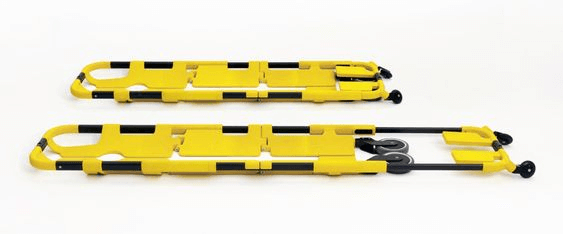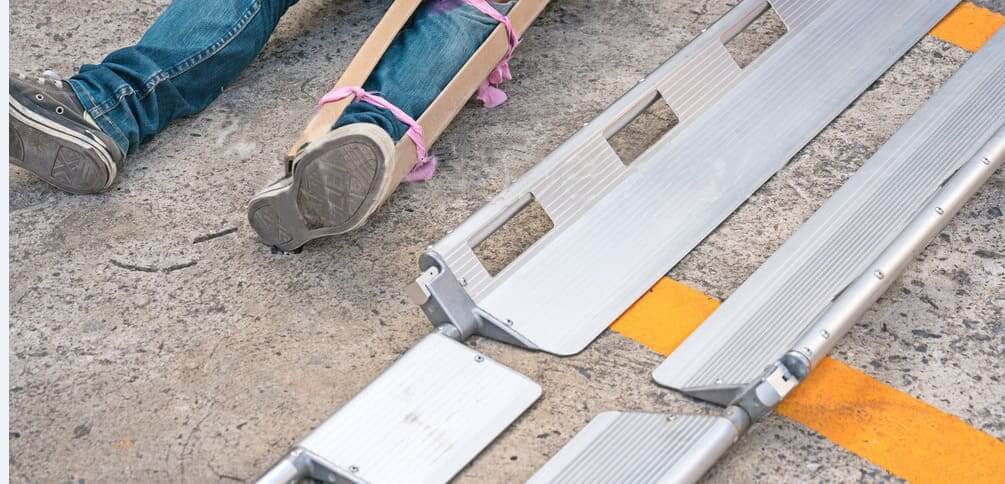A scoop stretcher is used to transport a patient with severe injuries. It is especially handy where spinal fractures are suspected. The stretcher does not require the patient to be rolled or lifted. Instead, it splits in half, making the lifting easier and safer.
Paramedics can split a scoop stretcher in half and slide it underneath the casualty. They can then use restraint belts to immobilize the patient for safe transportation.
A scoop stretcher has a hinged or connecting mechanism in the middle of its two ends. The mechanism allows for the stretcher to be split into two sections. This makes locking and unlocking the stretcher easy, which is excellent in an emergency.
Below is an image of a scoop stretcher.

A scoop stretcher is used in many rescue missions, including:
- Mountain rescue
- Urban rescue
- Combat rescue
- Entry rescue
We find out more below.
Table of Contents
ToggleMountain Rescue
Mountain rescues are carried out in steep and rocky terrains. Most mountain rescue missions help rescue caving or mountain climbing victims. They involve locating people trapped by rubble or malfunctioning instruments.
Paramedics use this type of rescue to locate missing people. A good number of caves are undocumented, which could easily bewilder explorers.
In these emergency situations, the following steps will save the day:
- Use climbing ropes to traverse the cave or mountain
- Identify the victim who needs help
- Return them to safety
So, why do paramedics prefer scoop stretchers to other types of stretchers?
Scoop stretchers will allow you to scoop the wounded off the ground instead of rolling them.
The photo below shows a rescued victim during a mountain rescue mission.

Alt: A rescued victim
Scoop stretchers also minimize the risk of unintentional movement during patient handover.
How does it achieve this?
It keeps the injured in a level position throughout before shifting them to a standard stretcher, if necessary. Scoop stretchers are also far more comfortable than spine stretchers.
Urban Rescue
Urban rescue is carried out to rescue victims from collapsed buildings.
It is a specialized rescue requiring diverse teams. Such teams may include firefighters and emergency medical technicians.
In an urban rescue mission, responders first focus on saving the lives of victims. After that, rescuers with specially trained search dogs look for victims trapped beneath the wreckage.
Urban rescue crews will frequently utilize specialized cameras to view beneath the rubble. They place victims on scoop stretchers to enhance their transportation to a nearby health facility.
Scoop stretchers are ideal for this rescue mission because of the following benefits:
- They are lightweight. This enables rescuers to move freely with the equipment during a rescue session.
- They come in ergonomic designs. Scoop stretchers have operator handles with ergonomic designs to enable proper lifting. This lowers the risk of further injuries due to manual handling.
- They can withstand compression, erosion, and wear. Scoop stretchers have an aluminum alloy tube that enables them to withstand compression, erosion, and wear. This also makes them durable.
- They are comfortable and safe. Scoop stretchers offer comfort and safety to patients who require spinal immobilization.
- They can be detached and pushed underneath. Transferring obese patients onto a stretcher is hectic. Besides, it is likely to cause injury to the patient. A scoop stretcher can be detached and pushed underneath a patient for easy lifting, as shown below.

Combat Rescue
Combat rescue is commonly applied during times of war. The primary purpose of a combat rescue is to find and rescue soldiers and injured civilians on the battlefield.
You can use different stretchers for this exercise, but a scoop stretcher is the best of them all. It is ideal because you can easily install it during emergencies. Below is a photo of a rescuer fixing a scoop stretcher:
Fixing a scoop stretcher involves elementary and straightforward steps, as highlighted below:
- Determine the patient’s height and adjust the scoop stretcher to match it. You can then lock the adjusting button.
- When adjusting the scoop, ensure both sides are aligned.
- Place the patient’s hands across the chest.
- Roll the patient slightly and push the scoop underneath them.
- Allow the patient to roll back and repeat the process on the other side of the scoop.
- Ensure the top and bottom of the scoop stretcher lock together.
- You can now lift the patient and move them to the ambulance.

Entry Rescue
The scoop stretcher is most helpful during entry rescues. An entry rescue mission is when medical professionals go to the patient, place them on a stretcher, and transport them to a nearby hospital. The issue with confined areas is that having medical personnel there raises the hazards.
When paramedics are not fully aware of the possible risks, the situation becomes even more disastrous.
However, with good guidance, the rescue session can be successful with the help of a scoop stretcher. A scoop stretcher makes it convenient to rescue victims due to its lightweight features.
Immobilizing the wounded party’s spine is incredibly crucial. While at it, consider the available space and other life-threatening circumstances, such as a toxic environment.
The “life over limb” principle guides the team in these rescue efforts. That means that the priority is given to rescuing a casualty alive, even if it means suffering a severe injury in the process. A scoop stretcher is ideal for use in this type of rescue session.
Conclusion
A scoop stretcher has a significant impact on our daily rescue missions. You can use a scoop stretcher in confined spaces that an ambulance cannot access. When you secure the patient to the scoop stretcher, you can lift them to an ambulance to ferry them to a nearby health facility. Sourcing your scoop stretcher from a reputable seller is a plus since it guarantees durability and efficiency.
Frequently Asked Questions
How many kilograms can a scoop stretcher hold?
A scoop stretcher can hold up to around 160 kilograms. However, it will also depend on the quality of the scoop stretcher. Some can only manage to hold less than 160 kilograms.
How much does a scoop stretcher cost?
A scoop stretcher costs between $50 and $150. The price will depend on their sizes, quality, and the brand itself.
What is the other name for scoop stretcher?
A scoop stretcher can also be called a clamshell. Other people call it a Roberson orthopedic stretcher or simply a scoop.



